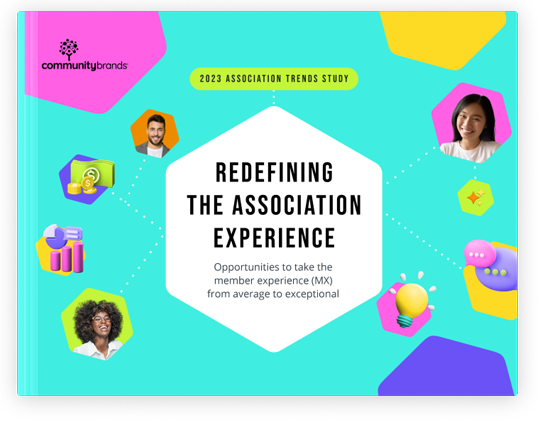Analyzing your association’s member data and putting it to work might seem challenging. But you can’t afford not to.
Read on to understand how failing to use your member data can harm your association, and what steps you can take to become a more data-driven organization.
By Caitlin Hustrulid, Marketing Manager, Community Brands
Does the idea of analyzing your association’s data and putting it to use feel like a tall order? If so, you aren’t alone. Many associations would like to use their member data to gain insights for more informed decision making, but various challenges keep them from moving forward.
There’s a problem with that, though. By avoiding the use of data, not only are you missing out on valuable insights, but you can actually harm your association.
Why do associations fail to use their member data?
Let’s take a step back to understand why associations don’t use their member data, even when they know data insights can be useful.
Many associations face challenges when it comes to data. In the 2021 Association Trends Study by Community Brands, association professionals say that their top member data challenges include using data analytics, processing/using their data, and finding the right tools to analyze data.
An article by McKinley Advisors about developing a data strategy that fits your association’s culture suggests that when an association avoids using data, it can be because of a lack of comfort with the underlying meaning of the information. Or it can be that the organization’s culture might lean more toward using their experience and instincts for decision making.
Why your association can’t afford not to use member data
Despite these challenges, associations can’t afford to sit out of the data game. Consider the following ways that failing to analyze and use your data can hurt your association:
- Inaccurate decision making – When you don’t have tools and techniques in place to help you put your member data to use, you don’t have accurate insights into the overall health of your organization. How can you keep your association going strong if you don’t know how well you’re tracking toward your goals?Without data insights, you also can’t make precise and well-informed business decisions. If each role across your organization houses data in different places and struggles to generate reports and view data, then they could each be making decisions based on different (and inaccurate) data. Or they could even be relying on hunches and instincts.
- Missed opportunities – Without clear views into your member data, you miss opportunities to create new member benefits and programs that can help you grow your membership and improve member satisfaction.
- A poor member experience and a hit to your revenue – If different roles in your organization are struggling to use data (or working with different sets of data to make decisions) your member experience suffers. Your organization isn’t using solid and consistent insights to make decisions about the programs and benefits you offer members. You’re missing opportunities to keep your organization growing and thriving. Eventually, you might lose members due to a poor member experience, and that means lost revenue.
Simple steps for more data-driven decision making
The impact of failing to use your member data might seem bleak. And moving toward more data-driven decision making might seem out of reach for your association.
But there’s good news: Becoming a data-driven organization is completely achievable, and it can help you avoid missteps, spot trends, and find new opportunities for growth.
You can start with a few simple steps, such as:
- Get a single view of your data. Using an all-in-one association management software (AMS) system like YourMembership AMS by Community Brands can help your entire organization collect, manage, analyze, and use your data more effectively.
- Define and monitor key performance indicators (KPIs). If you haven’t already done so, establish a list of KPI metrics that can help you track progress toward your association’s goals. Then, set up dashboards in your AMS system so that you have a quick, accurate overview of your association’s health every day.
- Set up detailed reports. In addition to setting up KPIs in your AMS dashboard, set up more detailed reports for each function in your association. For example, set up a membership report that shows overall membership trends (new members, lapsed members, etc.) as well as a breakdown of key membership demographics. And set up a marketing report that shows website visits, email open and click-through rates, and online member community engagement.
- Review data regularly. Plan a regular meeting to review reports for each key function in your organization. Talk about trends, what the data is telling you, what you might do to improve numbers that are moving in the wrong direction, and what opportunities the trends might present.
Learn more.
Using your member data to inform your business decisions makes it easier to manage your overall organization, plan programs, make improvements, and deliver a better member experience.
Discover more tips, tools, and techniques for becoming a data-driven association: Sign up to attend the upcoming webinar, How to become a data-driven organization with YourMembership AMS on March 29, 2022.







